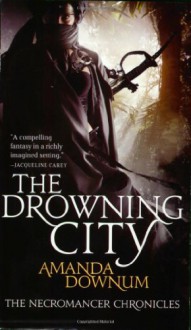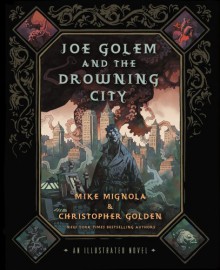Found just about everything at my local used book store, except for 3 crazy finds at the DOLLAR TREE, of all places (Joe Golem and the Drowning City, Charlotte Markham and the House of Darkling, and A Beautiful Blue Death).

Found just about everything at my local used book store, except for 3 crazy finds at the DOLLAR TREE, of all places (Joe Golem and the Drowning City, Charlotte Markham and the House of Darkling, and A Beautiful Blue Death).

This is a decent escapist fantasy, if you’re looking for a setting that hasn’t been done to death. If you’re looking for memorable characters, though, best look elsewhere.
Over the last several years there’s been a push for more diversity of characters and settings in fantasy, and it looks like Downum was listening. The Drowning City is populated mostly by non-white characters from a South-Asian-inspired culture – with a fantasy twist, including ghosts and spirits. The setting is this book’s biggest strength: the culture is well-developed and layered without feeling exoticized, and the scenes positively drip with sensory detail. To the point that after reading fewer than 15 pages, I put the book down to get Indian takeout. The fact that I found the descriptions so evocative but had little trouble setting the book aside sums up my experience of this novel.
The Drowning City follows the adventures of three women, who are basically indistinguishable from each other, aside from having different backstories and positions in the world. The protagonist, Isyllt, kicks off the action by arriving in Symir as a foreign spy, meant to destabilize the colonial government by providing aid to rebels. Which sounds sexy, but results in a protagonist who lacks a clear role in the developing struggle, or much motivation to take part. There’s also Xinai, who begins the story as Isyllt’s bodyguard but soon deserts to join a local terrorist group, and Zhirin, an apprentice mage. None have any personality to speak of, beyond a willingness to get into dangerous situations, and the only difference between them (beyond the variation in their assigned roles) is that the teenaged Zhirin is idealistic, while the two 20-somethings are jaded. Generic personalities kept me from investing in the characters, which forestalled any real interest in the story, with the result that even though this is an easy read with a reasonably-paced, adventure-oriented plot, it took me a long time to finish.
That said, the plot itself is fine, and may work well for younger fantasy readers or those seeking pure escapism. The writing is adequate, though definitely in the genre (as opposed to literary) category. The necromancy and magical phenomena are somewhat unusual, fit the mood of the story and aren’t over-explained. I hesitate to call it a standalone novel, because the end leaves open major questions in the political plot that may be addressed in the sequel (though that has an entirely different setting), but the book does tell a complete story. It proved to be a basically enjoyable light read, and gets points for a big, blow-everything-open climax. Still, though the sequel is supposed to be better, this one didn't provide much motivation to read on.
This was originally posted on Love in the Margins.
I was swayed to give this fantasy trilogy a try when I learned that one of the books would have a trans woman pov character. The numerous characters of colour, including several pov characters, were an added bonus. The books are written in third person limited voice.
The one character who ties the three books together, is a pale northern spy, Isyllt Iskaldur, who in The Drowning City travels south to Symir to incite a rebellion. It's a scheme to direct the Assari emperor's attention elsewhere to and protect her home Selafai. With her travels two mercenaries: Adam who isn't quite a human, and Xinai Lin who is returning home after having escaped the massacre of her family. Because of restless ghosts, Xinai, the second narrator, finds herself tangled with one of the rebelling groups. The third narrator, Zhirin Laii, helps Isyllt to connect with another faction.
I really liked the first book of the trilogy because of its tight pacing and the focus on plot. Also actual, lasting consequences, I liked those. There were some awkward parts, which reeked of infodumping, but they were quickly bypassed. There was just enough worldbuilding to make me curious and leave me wanting for more. After all, I had two more books to look forward to for further character building and expansion of the world.
In The Bone Palace Isyllt has returned home and is stuck in her day job as an investigator for the crown. She starts to enquire into a murder of a prostitute's, and is pulled into a conspiracy against King Mathiros. Isyllt is made to choose between her oaths to the throne and her old mentor-slash-lover.
The three narrators of the second book are Isyllt and Kiril, the pupil and master, and Savedra Severos of kinky hair, who escaped her fate as a prostitute—because what else is a transgender character to do in a thinly veiled real world—due to her family connections and by becoming crown prince Nikos' lover. She is also, a very dear friend of Nikos' wife, princess Ashlin.
This is where it all falls apart and moves firmly into the theory good, practice not territory. Instead of continuing with her strength as a plotter, Downum writes a story that relies on strong characterisations, which then are notably absent. Character continuity is sacrificed for a beautiful turn of a phrase and those very word choices make me doubt the author's ability to portray a trans character. It felt like I was always outside looking in and seeing Savedra's male body rather than being inside her head hearing a woman's thoughts. And I don't think Downum's version of a first person voice would have helped.
In The Kingdoms of Dust Isyllt travels to meet an old friend from book one. Their journey takes them south to possibly save the very empire they tried to undermine only a few years earlier.
Apart from the bisexuality default—makes reading easier if that's what you assume for every character—established in the second book, there wasn't much I liked about the final book. In a word, it's a mess. There are too many pov characters and once again actual character development and worldbuilding are ignored. There isn't even a hint of the strong plotting I was hoping would make a comeback. It got so bad that I didn't even care about the characters I'd loved in the first book.
It made me angry to see all the elements for a strong plot heavy story wasted in an aimless character study that didn't have actual character development. It also became impossible to ignore the Mary Sue'ness of the main character as once again another man succumbed to her charm. The ending could have saved a lot, but it didn't.
Final Assessment: Read The Drowning City as a standalone book (sans HEA) and skip the rest. It got a B from me whereas The Bone Palace and The Kingdoms of Dust get a D and an F respectively.
Source: Bought.
Series: The Necromancer Chronicles

Mostly I liked this story, but not as much as I had expected. Although I loved the half-drowned New York setting, and the parallel with horror works such as those of Lovecraft's, I found some of the descriptions redundant, and the villain not that impressive. More than anything, though, I wish we had seen more of Joe himself. Maybe it's my fascination with golems speaking, but I really wanted to see that part exploited more than it was.